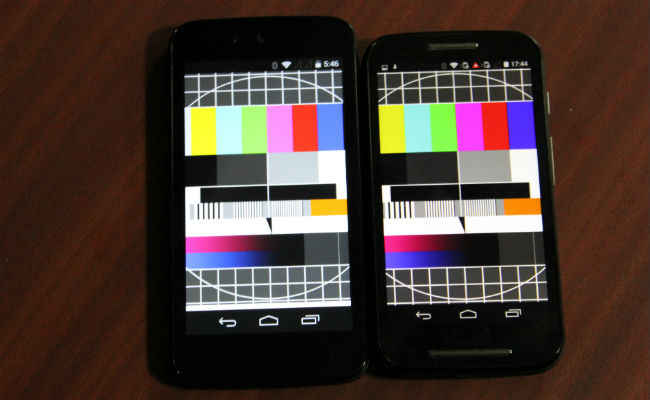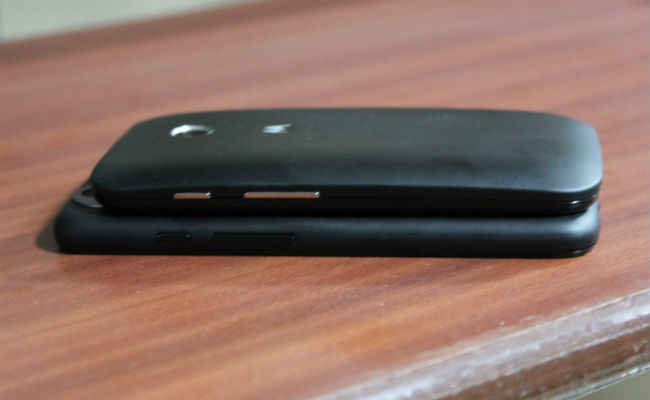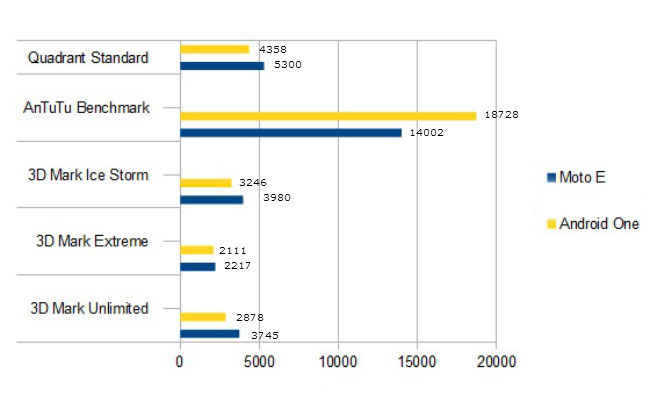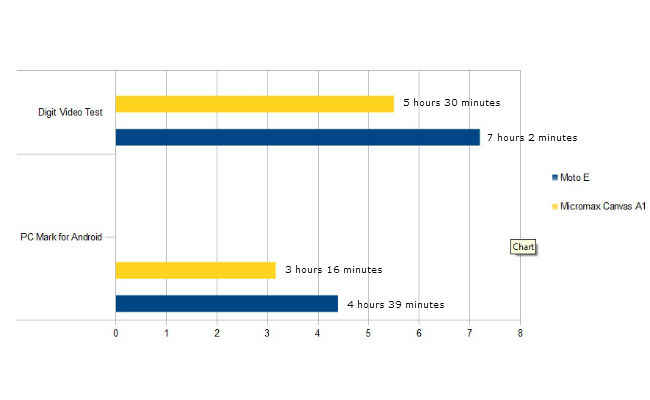Motorola Moto E vs Android One phones
The Android One smartphones haven't quite been as disruptive in the market as expected. Their biggest competitor is perhaps the Moto E. So, here's a test comparing the two.
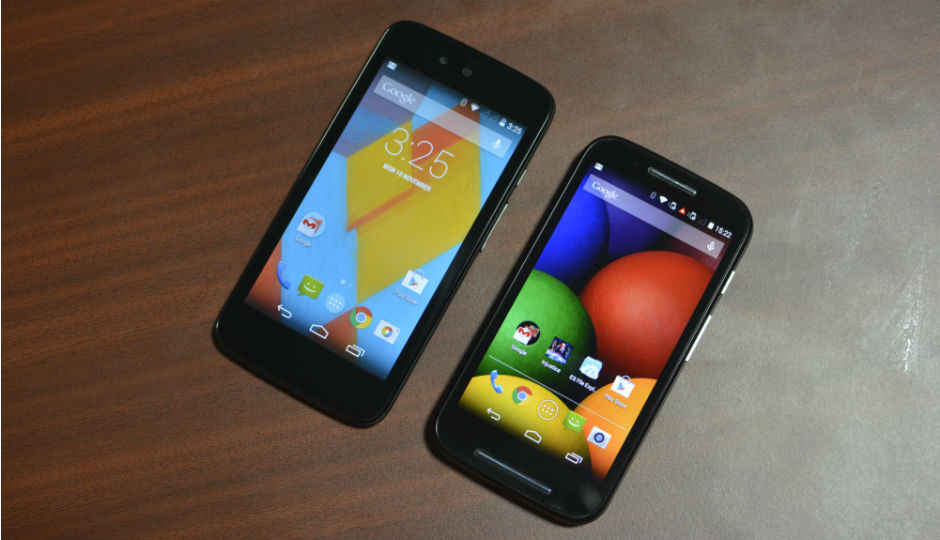
In many of our Android One reviews, we have said that the devices don’t offer anything more than the Moto E, especially considering the price. It occurs to us though that while we say that based on our own tests, we have not yet provided an objective analysis of the actual difference between the two phones. While the Moto E has sat atop the budget segment for a long time now, Android One hasn't been as disruptive as expected. Still, the devices from Micromax, Karbonn and Spice have Google handling the software department and do provide a lot of value.
 Survey
SurveySo, here’s an objective analysis of the two phones being pitted against each other. On the one hand is the Motorola Moto E and representing the Android One devices is the Micromax Canvas A1. If you remember, we called this the best budget effort that Micromax has ever made.
Display
On paper, the 256 ppi pixel density of the Moto E isn’t much higher than the 218 ppi of the Micromax Canvas A1. The Moto E though has a much brighter screen, with better colour reproduction than the Canvas A1. Images are visibly sharper on the Moto E and even though it is smaller, with a 4.3 inch display compared to the 4.5 inch on the Android One device, we would lean towards the Moto E in this department. In addition, the Corning Gorilla Glass 3 protection on the Moto E display doesn’t just make it strong, but also adds a very premium feel to the screen.
Winner: Moto E
Build and Design
While the Moto E’s display is brighter and sharper, it is still smaller. In addition, the Android One device is much lighter as well. The Moto E is a very compact design and would suit those who love small phones, but it is quite bulky and thick. The Canvas A1 on the other hand sports the bar design, with rounded corners and looks quite good for a budget smartphone. The 4.5 inch display makes it big, yet not big enough to become cumbersome to use, which gives it the slight edge in the design department.
Of course, this area has a lot to do with personal choice as well. The overall dimensions of the Moto E make it much smaller than the Android One phone. So, if you want a very small and compact phone, then go for the Moto E. The trade off will be the weight and thickness though. The Android One device, though bigger, is slimmer and lighter and feels very good in the hand.
Winner: Android One
Performance
This is where things get really interesting. While both the devices have 1 GB of RAM with Android 4.4.4 KitKat running on them, the Moto E has a 1.2 Ghz Qualcomm Snapdragon 200 dual-core SoC against the Android One device’s a 1.3 Ghz quad-core MediaTek processor. Now we’ve said often that a quad-core SoC doesn’t necessarily mean better performance. In fact, the Moto E has always been a very good example of this.
The extra cores on the Android One device though seem to give it better multitasking abilities. App launch times on the Micromax Canvas A1 were visibly less than the Moto E, even if by just a little bit. RAM management here is done by KitKat and both devices have the same amount of RAM, which means that it is more or less a battle between the SoCs. That said, the Moto E quickly became the leader when it came to gaming. The Adreno 302 GPU on the Moto E is not only faster, but also supports more 3D games. While the Adreno 302 can go up a speed of 1.5 Ghz, the Mali 400 on the Canvas A1 is capable of 600 Mhz only.
Even on synthetic benchmarks, the Moto E easily outperformed the Android One phone in 3D Mark, which tests the GPU performance. The Android One device though came out on top in AnTuTu, Quadrant and some others, which tests other aspects of the processor as well. It is quite apparent that while the Moto E is the choice for those who use their devices for gaming, the Android One phone seemed better for productivity users.
Now here’s where it gets tricky. The gaming performance on the Moto E and the productivity difference on the Android One smartphone becomes apparent only when the two devices are placed side by side. In regular usage, neither compares to a high end smartphone (obviously) and the trade off is really low. So who wins in this department? We’ll go with the Moto E and we’ll tell you why in the next segment. Read on.
Winner: Moto E
Battery
The Moto E lasts longer than the Android One smartphone and that is why we picked it as the better performer. While better productivity should have resulted in more marks, it shouldn’t compromise on the battery life. In our standard video tests, the Android One device gave us 5.5 hours, while the Moto E gave 7.2 hours, a good hour and a half more. Even on the PC Mark for Android benchmark, the Moto E lasts for 4 hours 39 minutes, while the Canvas A1 tops out at 3 hours 16 minutes.
Winner: Moto E
Camera
This is one area where the Moto E suffers a resounding loss, which is not really surprising. While the Android One phone has a very good camera for a 5 MP sensor, the Moto E's fixed focus 5 MP camera is one of its weakest aspects. The Canvas A1 on the other hand has good white balance and colour reproduction and the images are more than satisfactory.
Android One
Moto E
In addition, while the Android One phone comes with an LED flash accompanying the primary camera, the Moto E doesn't. Also, the Android One smartphone has a 2 MP front camera, which is another thing that is missing in the Moto E.
Winner: Android One
Storage
Both the devices have 4 GB of internal storage and are expandable up to 32 GB. This is another area where the Android One device is at a disadvantage though. You can not operate the camera on the Micromax Canvas A1 without inserting a memory card into the device. This means that you have to purchase an SD card in order to fully use this device. So, the real price of the Canvas A1 comes even closer to the Moto E.
Winner: Moto E
Call quality
Call quality on the two smartphones is equally good. Neither the Moto E nor the Micromax Canvas A1 had any static or other problems with calls. The in call volume was fine and we didn’t get any complaints from people on the other side of the call either.
Winner: Tie
Value
The Android One smartphones come in at Rs. 6,499, Rs. 5,999 and Rs. 6,190 for the Micromax Canvas A1, Karbonn Sparkle V and Spice Dream Uno respectively. As mentioned above, the fact that you can't use the camera without an SD card, adds about Rs. 500 to the cost. The Moto E on the other hand costs Rs. 6,999. Both the Android One smartphones and the Moto E come with 4 GB of internal storage and are expandable to 32 GB. Considering all that has been mentioned above, it seems to us that the Android One phones aren't priced low enough to provide better value than the Moto E. So, we have to go with the Moto E in this department as well.
Winner: Moto E
Bottomline
Looking at the above, it is evident that both these smartphones have their ups and downs, which basically brings it down to the brand value behind them. While Micromax, Karbonn and Spice have all upped their game in the recent past, Motorola is more of a veteran in the industry than any other. In addition, while the Moto E definitely lacks the camera quality, it more than makes up for it through its battery life and performance. The overall value is much more when it comes to the Moto E, which is why we pick the Moto E as the better overall smartphone in the budget range. The smartphone has been a stellar performer for those who have bought it till now and considering that Google hasn't really marketed the Android One devices as much as we thought it would, the Moto E remains the king of the budget segment. In fact, till now the Android One devices had the advantage of getting Android 5.0, but Motorola even matched that by announcing the update for the Moto E as well.
Winner: Moto E
Note: We realise that you would ask why the Xiaomi Redmi 1S hasn't been added to this comparison. We'll be adding the Redmi 1S update to this comparison very soon. Watch this space.
